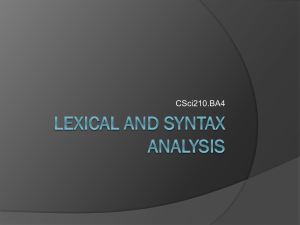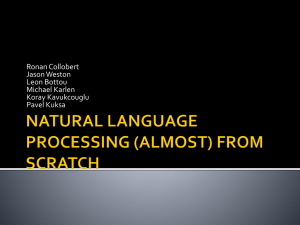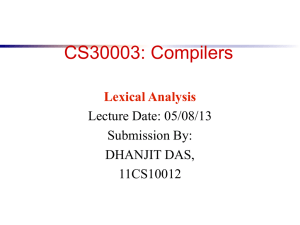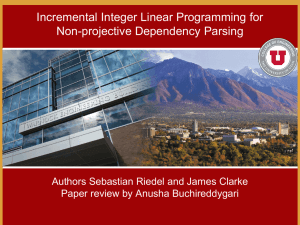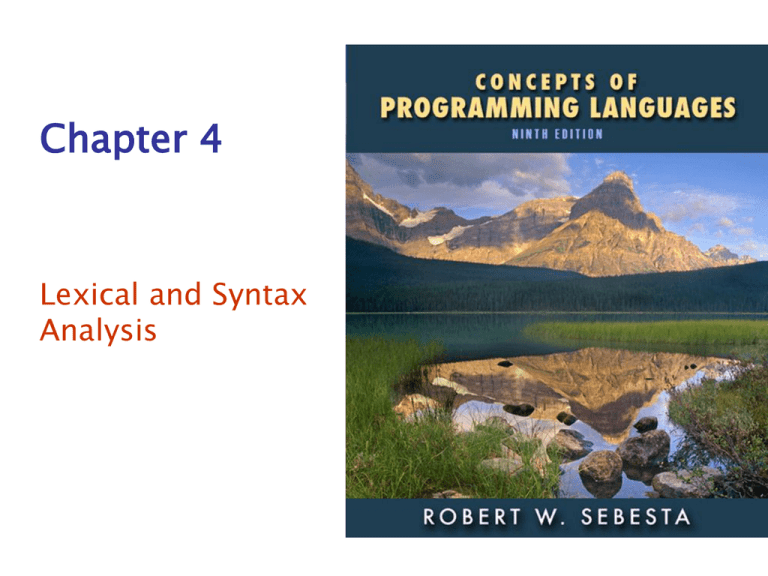
Chapter 4
Lexical and Syntax
Analysis
ISBN 0-321-49362-1
CS380 Test 1 #5
if ( expr1 ) stmts_1;
else if (expr2) stmts_2;
else stmts_3;
Operational semantics:
if (expr1 == fase ) goto L1
stmts_1;
goto LOUT
L1:
if (expr2 == false) goto L2
stmts_2;
goto LOUT
L2:
stmts_3;
LOUT:
Copyright © 2009 Addison-Wesley. All rights reserved.
1-2
Ch4 Syntax Analysis
• Based on BNF
• Two part:
– Lexical analyzer (scanner): low level part
(names, numerical literals …)
– Syntax analyzer (parser): high-level part (expr.,
stmts, prog. units), directly on BNF; portable
Copyright © 2009 Addison-Wesley. All rights reserved.
1-3
Lexical analysis, p.173
• Lexical analyzer is a pattern matcher for
character strings. Identify lexemes – extract
string (lexemes) from input and produce
tokens/lexemes
• Assignment stmt:
result = oldsum – value / 100;
lexeme
token
token code
result
ID
0
=
ASSIGN_OP
1
…
Copyright © 2009 Addison-Wesley. All rights reserved.
1-4
Lexical analysis, p.173
• Lexical analyzer is a function that is called
by the parser when it needs the next token
– Skip comments, blanks
– Insert user-defined names to the symbol table
used by the parser
– Detect syntactic errors in lexemes/token and
report to user.
Copyright © 2009 Addison-Wesley. All rights reserved.
1-5
Build a lexical analyzer, p.175
• Design a state diagram to describe the
tokens and write a program to implement
it. P.178, Figure 4.1.
Copyright © 2009 Addison-Wesley. All rights reserved.
1-6
Lab assignment, p.176 - 181
• C code
gcc front.c
./a.out > front.out
• p.177, file name: front.in (content of the
file is in p.181)
• Output file is similar to the output in p.181
Copyright © 2009 Addison-Wesley. All rights reserved.
1-7
The fun. getChar(), p.179
• Read the next char from input and put it to
nextChar (global varialbe)
• Determine its class (letter, digit, unknown)
charClass
Copyright © 2009 Addison-Wesley. All rights reserved.
1-8
Fun. addChar(), p.179
• Puts the char from nextChar into place the
lexeme is being accumulated – a string
name lexeme (global c-string)
Copyright © 2009 Addison-Wesley. All rights reserved.
1-9
Fun. Lookup(), p.178
• Determine the token values for operators,
and (, ).
Copyright © 2009 Addison-Wesley. All rights reserved.
1-10
Lexical analyzer lex(), p.180
• Letter Identifier
• Digit literal integer
• Unknown: operators (+, -, *, /), (, )
Copyright © 2009 Addison-Wesley. All rights reserved.
1-11
Parsing, p.182
• Syntax analysis
• Parser <--> syntax analyzer
• Goals:
– Find all syntax errors; produce diagnostic
message; recover quickly
– Produce parse tree, or at least a trace of parse
tree for the program
Copyright © 2009 Addison-Wesley. All rights reserved.
1-12
Parsing, p.182 (ctd)
• Two categories
– Top down: produce the tree from the root down
to the leaves. Use the order of the left-most
derivation
– Bottom up: from the leaves up to the root. Use
reverse order of the right most derivation
Copyright © 2009 Addison-Wesley. All rights reserved.
1-13
Top-down parser, p.183
• Sentence form
xAα
• x - terminals (a, b, c)
• A – non-terminals
• α – mixed
• Left most derivationA bB | cBb | a
depends on the next token/lexeme of input
Copyright © 2009 Addison-Wesley. All rights reserved.
1-14
Algorithms of top-down parsing, p.184
• Recursive descent parser: coded version
directly from the rules of BNF
• LL parser: use parsing table to implement
BNF
(Left-to-right scan of the input & left most
derivation)
Copyright © 2009 Addison-Wesley. All rights reserved.
1-15
Bottom up parser, p.184
• From leaves to root
• Produce a reverse of a right most derivation
… B
( B Ac)
… Ac
( A a)
… ac
β
B
A
c
a
Copyright © 2009 Addison-Wesley. All rights reserved.
1-16
Pair-wise dis-jointness test
• For non-left recursive grammar, p.193
• If true, parser can choose the correct RHS
on the next token of input
• If false, use left factoring process
• Assume
A αi | αj
• P.D.T. is
First(αi) ƞ First(αj) = 0 (non-intersect)
• First(αi) the first left terminal.
Copyright © 2009 Addison-Wesley. All rights reserved.
1-17
Pair-wise dis-jointness test (ctd)
• A aB | bAb | c
First (aB) = a
First (bAb) = b
first (c) = c
They are not intersected pass the P.D.T
Copyright © 2009 Addison-Wesley. All rights reserved.
1-18
P.190, Figure 4.2, Parse tree
• Code from p.186 – 189, recursive decent
parsing
• P.189, trace the code
Copyright © 2009 Addison-Wesley. All rights reserved.
1-19
Chapter 4 Topics
•
•
•
•
•
Introduction
Lexical Analysis
The Parsing Problem
Recursive-Descent Parsing
Bottom-Up Parsing
Copyright © 2009 Addison-Wesley. All rights reserved.
1-20
Introduction
• Language implementation systems must
analyze source code, regardless of the
specific implementation approach
• Nearly all syntax analysis is based on a
formal description of the syntax of the
source language (BNF)
Copyright © 2009 Addison-Wesley. All rights reserved.
1-21
Syntax Analysis
• The syntax analysis portion of a language
processor nearly always consists of two
parts:
– A low-level part called a lexical analyzer
(mathematically, a finite automaton based on a
regular grammar)
– A high-level part called a syntax analyzer, or
parser (mathematically, a push-down
automaton based on a context-free grammar,
or BNF)
Copyright © 2009 Addison-Wesley. All rights reserved.
1-22
Advantages of Using BNF to Describe
Syntax
• Provides a clear and concise syntax
description
• The parser can be based directly on the BNF
• Parsers based on BNF are easy to maintain
Copyright © 2009 Addison-Wesley. All rights reserved.
1-23
Reasons to Separate Lexical and Syntax
Analysis
• Simplicity - less complex approaches can
be used for lexical analysis; separating
them simplifies the parser
• Efficiency - separation allows optimization
of the lexical analyzer
• Portability - parts of the lexical analyzer
may not be portable, but the parser always
is portable
Copyright © 2009 Addison-Wesley. All rights reserved.
1-24
Lexical Analysis
• A lexical analyzer is a pattern matcher for
character strings
• A lexical analyzer is a “front-end” for the
parser
• Identifies substrings of the source program
that belong together - lexemes
– Lexemes match a character pattern, which is
associated with a lexical category called a token
– sum is a lexeme; its token may be IDENT
Copyright © 2009 Addison-Wesley. All rights reserved.
1-25
Lexical Analysis (continued)
• The lexical analyzer is usually a function that is
called by the parser when it needs the next token
• Three approaches to building a lexical analyzer:
– Write a formal description of the tokens and use a
software tool that constructs table-driven lexical
analyzers given such a description
– Design a state diagram that describes the tokens and
write a program that implements the state diagram
– Design a state diagram that describes the tokens and
hand-construct a table-driven implementation of the
state diagram
Copyright © 2009 Addison-Wesley. All rights reserved.
1-26
State Diagram Design
– A naïve state diagram would have a transition
from every state on every character in the
source language - such a diagram would be
very large!
Copyright © 2009 Addison-Wesley. All rights reserved.
1-27
Lexical Analysis (cont.)
• In many cases, transitions can be combined
to simplify the state diagram
– When recognizing an identifier, all uppercase
and lowercase letters are equivalent
• Use a character class that includes all letters
– When recognizing an integer literal, all digits are
equivalent - use a digit class
Copyright © 2009 Addison-Wesley. All rights reserved.
1-28
Lexical Analysis (cont.)
• Reserved words and identifiers can be
recognized together (rather than having a
part of the diagram for each reserved word)
– Use a table lookup to determine whether a
possible identifier is in fact a reserved word
Copyright © 2009 Addison-Wesley. All rights reserved.
1-29
Lexical Analysis (cont.)
• Convenient utility subprograms:
– getChar - gets the next character of input, puts
it in nextChar, determines its class and puts
the class in charClass
– addChar - puts the character from nextChar
into the place the lexeme is being accumulated,
lexeme
– lookup - determines whether the string in
lexeme is a reserved word (returns a code)
Copyright © 2009 Addison-Wesley. All rights reserved.
1-30
State Diagram to recognize names, parentheses, and
:
arithmetic operators
getChar()
Copyright © 2009 Addison-Wesley. All rights reserved.
1-31
Lexical Analyzer
Implementation:
SHOW front.c (pp. 176-181)
- Following is the output of the lexical analyzer of
front.c when used on (sum + 47) / total
Next
Next
Next
Next
Next
Next
Next
Next
token
token
token
token
token
token
token
token
is:
is:
is:
is:
is:
is:
is:
is:
25
11
21
10
26
24
11
-1
Next
Next
Next
Next
Next
Next
Next
Next
lexeme
lexeme
lexeme
lexeme
lexeme
lexeme
lexeme
lexeme
is
is
is
is
is
is
is
is
(
sum
+
47
)
/
total
EOF
Copyright © 2009 Addison-Wesley. All rights reserved.
1-32
The Parsing Problem
• Goals of the parser, given an input
program:
– Find all syntax errors; for each, produce an
appropriate diagnostic message and recover
quickly
– Produce the parse tree, or at least a trace of the
parse tree, for the program
Copyright © 2009 Addison-Wesley. All rights reserved.
1-33
The Parsing Problem (cont.)
• Two categories of parsers
– Top down - produce the parse tree, beginning
at the root
• Order is that of a leftmost derivation
• Traces or builds the parse tree in preorder
– Bottom up - produce the parse tree, beginning
at the leaves
• Order is that of the reverse of a rightmost derivation
• Useful parsers look only one token ahead in
the input
Copyright © 2009 Addison-Wesley. All rights reserved.
1-34
The Parsing Problem (cont.)
• Top-down Parsers
– Given a sentential form, xA , the parser must
choose the correct A-rule to get the next
sentential form in the leftmost derivation, using
only the first token produced by A
• The most common top-down parsing
algorithms:
– Recursive descent - a coded implementation
– LL parsers - table driven implementation
Copyright © 2009 Addison-Wesley. All rights reserved.
1-35
The Parsing Problem (cont.)
• Bottom-up parsers
– Given a right sentential form, , determine what
substring of is the right-hand side of the rule
in the grammar that must be reduced to
produce the previous sentential form in the
right derivation
– The most common bottom-up parsing
algorithms are in the LR family
Copyright © 2009 Addison-Wesley. All rights reserved.
1-36
The Parsing Problem (cont.)
• The Complexity of Parsing
– Parsers that work for any unambiguous
grammar are complex and inefficient ( O(n3),
where n is the length of the input )
– Compilers use parsers that only work for a
subset of all unambiguous grammars, but do it
in linear time ( O(n), where n is the length of the
input )
Copyright © 2009 Addison-Wesley. All rights reserved.
1-37
Recursive-Descent Parsing
• There is a subprogram for each
nonterminal in the grammar, which can
parse sentences that can be generated by
that nonterminal
• EBNF is ideally suited for being the basis for
a recursive-descent parser, because EBNF
minimizes the number of nonterminals
Copyright © 2009 Addison-Wesley. All rights reserved.
1-38
Recursive-Descent Parsing (cont.)
• A grammar for simple expressions:
<expr> <term> {(+ | -) <term>}
<term> <factor> {(* | /) <factor>}
<factor> id | int_constant | ( <expr> )
Copyright © 2009 Addison-Wesley. All rights reserved.
1-39
Recursive-Descent Parsing (cont.)
• Assume we have a lexical analyzer named
lex, which puts the next token code in
nextToken
• The coding process when there is only one
RHS:
– For each terminal symbol in the RHS, compare it
with the next input token; if they match,
continue, else there is an error
– For each nonterminal symbol in the RHS, call its
associated parsing subprogram
Copyright © 2009 Addison-Wesley. All rights reserved.
1-40
Recursive-Descent Parsing (cont.)
/* Function expr
Parses strings in the language
generated by the rule:
<expr> → <term> {(+ | -) <term>}
*/
void expr() {
printf ( “Enter <expr>\n”);
/* Parse the first term */
term();
/* As long as the next token is + or -, call
lex to get the next token and parse the
next term */
while (nextToken == ADD_OP ||
nextToken == SUB_OP){
lex();
term();
}
printf ( “Exit <expr>\n”);
}
Copyright © 2009 Addison-Wesley. All rights reserved.
1-41
Recursive-Descent Parsing (cont.)
• This particular routine does not detect errors
• Convention: Every parsing routine leaves the next
token in nextToken
Copyright © 2009 Addison-Wesley. All rights reserved.
1-42
Recursive-Descent Parsing (cont.)
• A nonterminal that has more than one RHS
requires an initial process to determine
which RHS it is to parse
– The correct RHS is chosen on the basis of the
next token of input (the lookahead)
– The next token is compared with the first token
that can be generated by each RHS until a match
is found
– If no match is found, it is a syntax error
Copyright © 2009 Addison-Wesley. All rights reserved.
1-43
Recursive-Descent Parsing (cont.)
/* term
Parses strings in the language generated by the rule:
<term> -> <factor> {(* | /) <factor>)
*/
void term() {
printf("Enter <term>\n");
/* Parse the first factor */
factor();
/* As long as the next token is * or /,
next token and parse the next factor */
while (nextToken == MULT_OP || nextToken == DIV_OP) {
lex();
factor();
}
printf("Exit <term>\n");
} /* End of function term */
Copyright © 2009 Addison-Wesley. All rights reserved.
1-44
Recursive-Descent Parsing (cont.)
/* Function factor
Parses strings in the language
generated by the rule:
<factor> -> id | (<expr>) */
void factor() {
/* Determine which RHS */
if (nextToken) == ID_CODE || nextToken == INT_CODE)
/* For the RHS id, just call lex */
lex();
/* If the RHS is (<expr>) – call lex to pass over the left parenthesis,
call expr, and check for the right parenthesis */
else if (nextToken == LP_CODE) {
lex();
expr();
if (nextToken == RP_CODE)
lex();
else
error();
} /* End of else if (nextToken == ... */
else error(); /* Neither RHS matches */
}
Copyright © 2009 Addison-Wesley. All rights reserved.
1-45
Recursive-Descent Parsing (cont.)
- Trace of the lexical and syntax analyzers on
Next token is:
Enter <expr>
Enter <term>
Enter <factor>
Next token is:
Enter <expr>
Enter <term>
Enter <factor>
Next token is:
Exit <factor>
Exit <term>
Next token is:
Enter <term>
Enter <factor>
Next token is:
Exit <factor>
Exit <term>
Exit <expr>
Next token is:
Exit <factor>
25 Next lexeme is (
11 Next lexeme is sum
(sum + 47) / total
Next token is: 11 Next lexeme is total
Enter <factor>
Next token is: -1 Next lexeme is EOF
Exit <factor>
Exit <term>
Exit <expr>
21 Next lexeme is +
10 Next lexeme is 47
26 Next lexeme is )
24 Next lexeme is /
Copyright © 2009 Addison-Wesley. All rights reserved.
1-46
Recursive-Descent Parsing (cont.)
• The LL Grammar Class
– The Left Recursion Problem
• If a grammar has left recursion, either direct or
indirect, it cannot be the basis for a top-down
parser
– A grammar can be modified to remove left recursion
For each nonterminal, A,
1. Group the A-rules as A → Aα1 | … | Aαm | β1 | β2 | … |
βn
where none of the β‘s begins with A
2. Replace the original A-rules with
A → β1A’ | β2A’ | … | βnA’
A’ → α1A’ | α2A’ | … | αmA’ | ε
Copyright © 2009 Addison-Wesley. All rights reserved.
1-47
Recursive-Descent Parsing (cont.)
• The other characteristic of grammars that
disallows top-down parsing is the lack of
pairwise disjointness
– The inability to determine the correct RHS on
the basis of one token of lookahead
– Def: FIRST() = {a | =>* a }
(If =>* , is in FIRST())
Copyright © 2009 Addison-Wesley. All rights reserved.
1-48
Recursive-Descent Parsing (cont.)
• Pairwise Disjointness Test:
– For each nonterminal, A, in the grammar that
has more than one RHS, for each pair of rules, A
i and A j, it must be true that
FIRST(i) ⋂ FIRST(j) =
• Examples:
A a | bB | cAb
A a | aB
Copyright © 2009 Addison-Wesley. All rights reserved.
1-49
Recursive-Descent Parsing (cont.)
• Left factoring can resolve the problem
Replace
<variable> identifier | identifier [<expression>]
with
<variable> identifier <new>
<new> | [<expression>]
or
<variable> identifier [[<expression>]]
(the outer brackets are metasymbols of EBNF)
Copyright © 2009 Addison-Wesley. All rights reserved.
1-50
Bottom-up Parsing
• The parsing problem is finding the correct
RHS in a right-sentential form to reduce to
get the previous right-sentential form in
the derivation
Copyright © 2009 Addison-Wesley. All rights reserved.
1-51
Bottom-up Parsing (cont.)
•Intuition about handles:
– Def: is the handle of the right sentential form
= w if and only if S =>*rm Aw =>rm w
– Def: is a phrase of the right sentential form
if and only if S =>* = 1A2 =>+ 12
– Def: is a simple phrase of the right sentential
form if and only if S =>* = 1A2 => 12
Copyright © 2009 Addison-Wesley. All rights reserved.
1-52
Bottom-up Parsing (cont.)
• Intuition about handles (continued):
– The handle of a right sentential form is its
leftmost simple phrase
– Given a parse tree, it is now easy to find the
handle
– Parsing can be thought of as handle pruning
Copyright © 2009 Addison-Wesley. All rights reserved.
1-53
Bottom-up Parsing (cont.)
• Shift-Reduce Algorithms
– Reduce is the action of replacing the handle on
the top of the parse stack with its
corresponding LHS
– Shift is the action of moving the next token to
the top of the parse stack
Copyright © 2009 Addison-Wesley. All rights reserved.
1-54
Bottom-up Parsing (cont.)
• Advantages of LR parsers:
– They will work for nearly all grammars that
describe programming languages.
– They work on a larger class of grammars than
other bottom-up algorithms, but are as efficient
as any other bottom-up parser.
– They can detect syntax errors as soon as it is
possible.
– The LR class of grammars is a superset of the
class parsable by LL parsers.
Copyright © 2009 Addison-Wesley. All rights reserved.
1-55
Bottom-up Parsing (cont.)
• LR parsers must be constructed with a tool
• Knuth’s insight: A bottom-up parser could
use the entire history of the parse, up to
the current point, to make parsing
decisions
– There were only a finite and relatively small
number of different parse situations that could
have occurred, so the history could be stored in
a parser state, on the parse stack
Copyright © 2009 Addison-Wesley. All rights reserved.
1-56
Bottom-up Parsing (cont.)
• An LR configuration stores the state of an
LR parser
(S0X1S1X2S2…XmSm, aiai+1…an$)
Copyright © 2009 Addison-Wesley. All rights reserved.
1-57
Bottom-up Parsing (cont.)
• LR parsers are table driven, where the
table has two components, an ACTION
table and a GOTO table
– The ACTION table specifies the action of the
parser, given the parser state and the next
token
• Rows are state names; columns are terminals
– The GOTO table specifies which state to put
on top of the parse stack after a reduction
action is done
• Rows are state names; columns are nonterminals
Copyright © 2009 Addison-Wesley. All rights reserved.
1-58
Structure of An LR Parser
Copyright © 2009 Addison-Wesley. All rights reserved.
1-59
Bottom-up Parsing (cont.)
• Initial configuration: (S0, a1…an$)
• Parser actions:
– If ACTION[Sm, ai] = Shift S, the next
configuration is:
(S0X1S1X2S2…XmSmaiS, ai+1…an$)
– If ACTION[Sm, ai] = Reduce A and S =
GOTO[Sm-r, A], where r = the length of , the
next configuration is
(S0X1S1X2S2…Xm-rSm-rAS, aiai+1…an$)
Copyright © 2009 Addison-Wesley. All rights reserved.
1-60
Bottom-up Parsing (cont.)
• Parser actions (continued):
– If ACTION[Sm, ai] = Accept, the parse is
complete and no errors were found.
– If ACTION[Sm, ai] = Error, the parser calls an
error-handling routine.
Copyright © 2009 Addison-Wesley. All rights reserved.
1-61
LR Parsing Table
Copyright © 2009 Addison-Wesley. All rights reserved.
1-62
Bottom-up Parsing (cont.)
• A parser table can be generated from a
given grammar with a tool, e.g., yacc
Copyright © 2009 Addison-Wesley. All rights reserved.
1-63
Summary
• Syntax analysis is a common part of language
implementation
• A lexical analyzer is a pattern matcher that isolates
small-scale parts of a program
– Detects syntax errors
– Produces a parse tree
• A recursive-descent parser is an LL parser
– EBNF
• Parsing problem for bottom-up parsers: find the
substring of current sentential form
• The LR family of shift-reduce parsers is the most
common bottom-up parsing approach
Copyright © 2009 Addison-Wesley. All rights reserved.
1-64



